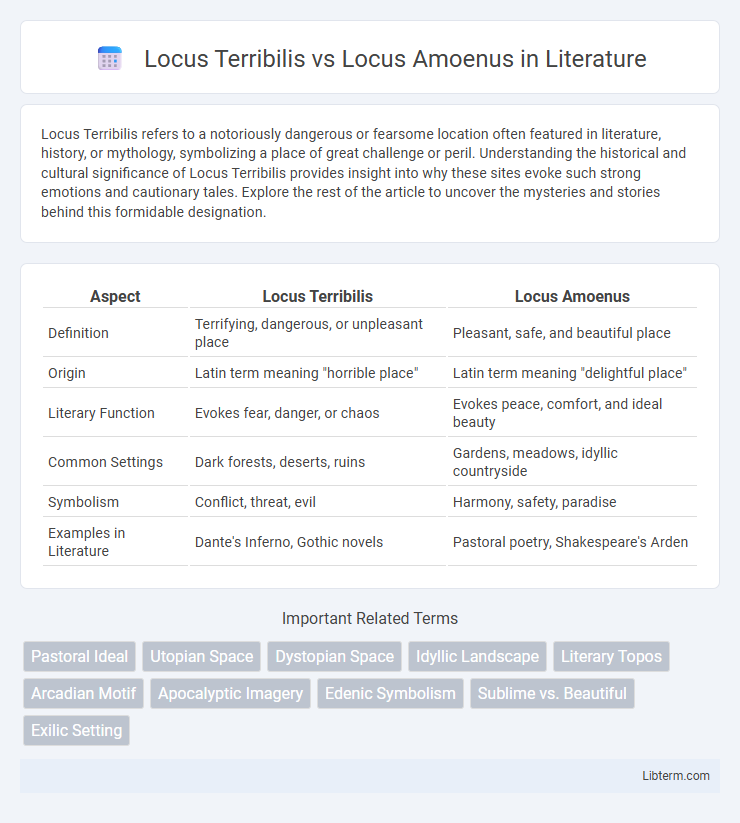Locus Terribilis refers to a notoriously dangerous or fearsome location often featured in literature, history, or mythology, symbolizing a place of great challenge or peril. Understanding the historical and cultural significance of Locus Terribilis provides insight into why these sites evoke such strong emotions and cautionary tales. Explore the rest of the article to uncover the mysteries and stories behind this formidable designation.
Table of Comparison
| Aspect | Locus Terribilis | Locus Amoenus |
|---|---|---|
| Definition | Terrifying, dangerous, or unpleasant place | Pleasant, safe, and beautiful place |
| Origin | Latin term meaning "horrible place" | Latin term meaning "delightful place" |
| Literary Function | Evokes fear, danger, or chaos | Evokes peace, comfort, and ideal beauty |
| Common Settings | Dark forests, deserts, ruins | Gardens, meadows, idyllic countryside |
| Symbolism | Conflict, threat, evil | Harmony, safety, paradise |
| Examples in Literature | Dante's Inferno, Gothic novels | Pastoral poetry, Shakespeare's Arden |
Introduction to Locus Terribilis and Locus Amoenus
Locus Terribilis and Locus Amoenus represent contrasting literary landscapes, with Locus Terribilis embodying scenes of danger, decay, and horror that evoke fear and discomfort. Locus Amoenus, in contrast, describes idyllic, serene settings often characterized by natural beauty, safety, and harmony, symbolizing an idealized refuge. These literary concepts serve as powerful tools for authors to explore themes of conflict and peace, using physical environments to reflect psychological and moral states.
Defining Locus Amoenus: The Pleasant Place
Locus Amoenus, meaning "pleasant place" in Latin, refers to an idealized, serene setting characterized by natural beauty, lush greenery, gentle waters, and calm atmosphere, often depicted in classical literature as a sanctuary or paradise. This concept contrasts with Locus Terribilis, which denotes a frightening or dreadful place, highlighting safety, comfort, and harmony in Locus Amoenus. It frequently symbolizes escape, renewal, and idyllic peace, serving as a backdrop for poetic and narrative themes of refuge and tranquility.
Exploring Locus Terribilis: The Fearful Place
Locus Terribilis represents an environment imbued with fear, danger, and chaos, contrasting sharply with the serene and idyllic qualities of Locus Amoenus. This concept often appears in literature and mythology as a symbolic setting where characters confront inner and external turmoil, highlighting themes of dread and conflict. Analyzing Locus Terribilis unveils its role in intensifying narrative tension and exploring the psychological dimensions of fear and adversity.
Historical Origins of Both Concepts
Locus Terribilis and Locus Amoenus originate from classical literature, where Locus Amoenus describes idyllic, safe, and pleasant settings often portrayed in Roman poetry by authors like Virgil, while Locus Terribilis refers to frightening, dangerous, or chaotic places found in works reflecting darker themes. The historical distinction between these terms arises from their contrasting depictions of space, used by ancient writers to emphasize moral, psychological, or thematic elements in narratives. Both concepts have roots in Greco-Roman traditions, serving as foundational tropes in Western literary and cultural history.
Literary Examples of Locus Amoenus
Locus Amoenus, characterized by idyllic, peaceful settings such as lush gardens or serene landscapes, appears vividly in literary works like Dante's "Divine Comedy," where the Earthly Paradise represents purity and renewal. Shakespeare's "A Midsummer Night's Dream" features the enchanted forest as a classic locus amoenus offering refuge and magic. These examples emphasize how the locus amoenus serves as a symbol of harmony and escape in contrast to the threatening and hostile environment found in locus terribilis.
Notable Instances of Locus Terribilis in Literature
Notable instances of locus terribilis in literature include the dark, haunted forest in Shakespeare's "Macbeth," where the atmosphere evokes fear and chaos, and the desolate moor in Emily Bronte's "Wuthering Heights," symbolizing turmoil and wildness. Another prime example is the dystopian cityscape in George Orwell's "1984," representing oppression and despair. These settings contrast sharply with locus amoenus scenes, which are characterized by order, peace, and natural beauty.
Symbolic Contrasts: Safety vs. Danger
The symbolic contrast between Locus Terribilis and Locus Amoenus highlights the dichotomy of safety versus danger in literature and art. Locus Amoenus represents an idyllic, safe space characterized by harmony, comfort, and natural beauty, evoking feelings of peace and refuge. In stark opposition, Locus Terribilis embodies a threatening, hostile environment filled with peril, chaos, and fear, symbolizing existential danger and psychological turmoil.
Function and Purpose in Narrative Structure
Locus Terribilis functions in narrative structure as a symbol of fear, chaos, or moral corruption, heightening tension and conflict to challenge characters' resilience and growth. Locus Amoenus serves as a contrasting motif, providing a safe, idealized environment that facilitates reflection, healing, or the restoration of order. Together, these settings structure the narrative's emotional arc by juxtaposing danger and sanctuary, driving character development and thematic exploration.
Psychological Impact on Readers and Characters
The contrast between Locus Terribilis and Locus Amoenus significantly influences the psychological states of both readers and characters by evoking intense emotional responses; Locus Terribilis, often depicted as a terrifying or hostile environment, induces fear, anxiety, and tension, heightening the sense of conflict or danger. In contrast, Locus Amoenus represents an idealized, safe, and harmonious space, promoting feelings of peace, comfort, and escapism, which can provide characters and readers with relief or a restorative psychological refuge. This dynamic interplay shapes narrative tension and emotional engagement by manipulating spatial symbolism to mirror internal psychological landscapes.
Enduring Influence on Modern Storytelling
Locus Terribilis and Locus Amoenus remain foundational archetypes in modern storytelling, symbolizing contrasting environments of terror and idyllic safety that deeply influence narrative tension and character development. The enduring appeal of Locus Terribilis lies in its ability to evoke fear and challenge protagonists through settings like haunted forests or desolate landscapes, while Locus Amoenus provides sanctuary and peace, often serving as a transformative space for growth or reflection. Contemporary literature, film, and gaming consistently leverage these motifs to create immersive worlds that resonate emotionally with audiences, ensuring their relevance across diverse genres and mediums.
Locus Terribilis Infographic

 libterm.com
libterm.com